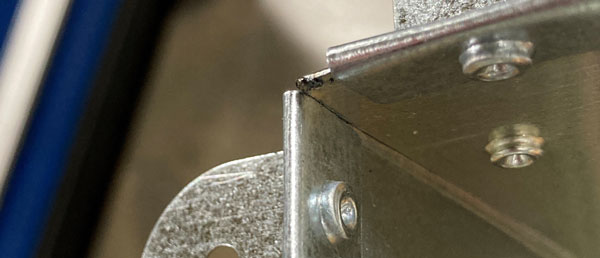
Self-Pierce Riveting is a process that uses special tooling and self-piercing semi-tubular rivets to join components without predrilled holes. Similar to Impact Riveting, rivets are fed down a track into tooling that installs the rivet into the workpiece. The difference is that the rivet is designed to pierce through the components upon impact as the upper tooling drives the rivet into the lower tooling, securing the components together. Self-piercing rivets can join sheet metal and other thin materials together, even if the materials are dissimilar.

There are several advantages to using the self-pierce riveting process, including:
- Reduced cycle time of less than one second
- Part cost efficiency when using standard rivets
- No predrilling of holes
- Ability to process multiple parts without changeover
- Small machine footprint
- And more!
Recently, an automotive manufacturer turned to Orbitform, looking for a self-pierce riveter to support their R&D work. This equipment would be set up in their lab to install different-length rivets to assemble parts of varying thicknesses without predrilled holes. Once approved, these parts would be tested and handed off to their production facilities. They wanted something similar to the existing production equipment that allowed them the flexibility to assemble the different part configurations.

To support this request, Orbitform provided the manufacturer with a Milford Model 405-VH Impact Riveter outfitted with special tooling to allow them to install their self-piercing rivets without needing to predrill holes into their parts. To match their current production equipment, which was not an Orbitform brand, the manufacturer sent us their existing tooling, and we were able to reverse-engineer our tooling to match.
In addition to the special tooling, we provided a vibratory hopper instead of the standard rotary hopper. The vibratory hopper allowed the customer to accommodate the various rivet lengths, including any rivets too small to feed with a rotary hopper. The vibratory hopper also provided the capacity to hold a larger quantity of rivets if they needed to run larger batches of parts.
Throughout this project, the Project Manager and engineering team worked closely with the manufacturer’s engineers to fully understand their needs. The result was a versatile self-pierce riveter with the proper flexibility to support their R&D work.

Whether it’s standard assembly equipment, a custom solution, or somewhere in between, our Assembly Experts work with you every step to ensure your equipment meets your requirements. Contact us today to discuss your assembly equipment requirements.
